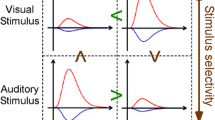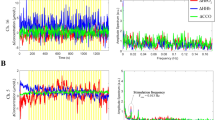Abstract
The aims were (1) to determine the sensitivity and reproducibility to detect the hemodynamic responses and optical neuronal signals to brain stimulation by near-infrared spectroscopy (NIRS) and evoked potentials by electroencephalography (EEG) and (2) to test the effect of novel filters on the signal-to-noise ratio. This was achieved by simultaneous NIRS and EEG measurements in 15 healthy adults during visual stimulation. Each subject was measured three times on three different days. The sensitivity of NIRS to detect hemodynamic responses was 55.2 % with novel filtering and 40 % without. The reproducibility in single subjects was low. For the EEG, the sensitivity was 86.4 % and the reproducibility 57.1 %. An optical neuronal signal was not detected, although novel filtering considerably reduced noise.







Similar content being viewed by others
Notes
One measurement could not be evaluated. Therefore, this subject is not included in the total number of subjects.
When DDOLS could not be applied, the columns are marked by “n.a.” in Table 1.
This is the case in the following 3 recordings: subject 7, recording B, and in subject 12, recordings A and B.
References
Benavente I, Tamargo P, Tajada N, Yuste V, Oliván M (2005) Flash visually evoked potentials in the newborn and their maturation during the first six months of life. Doc Ophthalmol 110(2):255–263. doi:10.1007/s10633-005-0818-0, http://dx.doi.org/10.1007/s10633-005-0818-0
Echallier J, Perrin F, Pernier J (1992) Computer-assisted placement of electrodes on the human head. Electroencephalogr Clin Neurophysiol 82(2):160–163. doi:10.1016/0013-4694(92)90161-A, http://www.sciencedirect.com/science/article/B6SYX-482RBC6-D5/2/0491640708cb970c66a55d84c181ee0d
Franceschini M, Boas D (2004) Noninvasive measurement of neuronal activity with near-infrared optical imaging. Neuroimage 21(1):372–386
Gratton G, Corballis P (1995) Removing the heart from the brain: compensation for the pulse artifact in the photon migration signal. Psychophysiology 32(3):292–299
Gratton G, Fabiani M (2010) Fast optical imaging of human brain function. Front Hum Neurosci 4:52
Haensse D, Szabo P, Brown D, Fauchère JC, Niederer P, Bucher HU, Wolf M (2005) A new multichannel near infrared spectrophotometry system for functional studies of the brain in adults and neonates. Opt Express 13(12):4525–4538. http://www.opticsexpress.org/abstract.cfm?URI=oe-13-12-4525
Haensse DV (2005) Changes in cerebral oxygenation in response to various stimuli in newborns as measured by functional near-infrared spectroscopy. PhD thesis, ETH Zurich, diss. ETH No. 16356
Ikeda H, Nishijo H, Miyamoto K, Tamura R, Endo S, Ono T (1998) Generators of visual evoked potentials investigated by dipole tracing in the human occipital cortex. Neuroscience 84(3):723–739. doi:10.1016/S0306-4522(97)00569-1, http://www.sciencedirect.com/science/article/B6T0F-3TDPWM5-8/2/4ad7fa3564d376c4bb74d2f3037bacfe
Jaspers HH (1958) Report of the committee on methods of clinical examination in electroencephalography: 1957. Electroencephalogr Clin Neurophysiol 10(2):370–375. doi:10.1016/0013-4694(58)90053-1, http://www.sciencedirect.com/science/article/B6SYX-482YFXP-2S/2/86bdd4bf9cfe6840aec22a5482f1ee66
Kocsis L, Herman P, Eke A (2006) The modified Beer–Lambert law revisited. Phys Med Biol 51:N91
Kono T, Matsuo K, Tsunashima K, Kasai K, Takizawa R, Rogers MA, Yamasue H, Yano T, Taketani Y, Kato N (2007) Multiple-time replicability of near-infrared spectroscopy recording during prefrontal activation task in healthy men. Neurosci Res 57(4):504–512. doi:10.1016/j.neures.2006.12.007, http://www.sciencedirect.com/science/article/B6T0H-4MMPNDG-1/2/21bd601882b23e3aa350f823c5f03345
Machielsen W, Rombouts S, Barkhof F, Scheltens P, Witter M (2000) Fmri of visual encoding: reproducibility of activation. Hum Brain Mapp 9(3):156–164
Medvedev AV, Kainerstorfer J, Borisov SV, Barbour RL, VanMeter J (2008) Event-related fast optical signal in a rapid object recognition task: Improving detection by the independent component analysis. Brain Res 1236:145–158. doi:10.1016/j.brainres.2008.07.122, http://www.sciencedirect.com/science/article/B6SYR-4T6CTR7-6/2/b70eca0903fa2f4a6593dea0005a3904
Odom JV, Bach M, Barber C, Brigell M, Marmor MF, Tormene AP, Holder GE, Vaegan (2004) Visual evoked potentials standard (2004). Doc Ophthalmol 108(2):115–123. doi:10.1023/B:DOOP.0000036790.67234.22, http://dx.doi.org/10.1023/B:DOOP.0000036790.67234.22
Plichta M, Herrmann M, Baehne C, Ehlis AC, Richter M, Pauli P, Fallgatter A (2006) Event-related functional near-infrared spectroscopy (fnirs): are the measurements reliable? Neuroimage 31(1):116–124. doi:10.1016/j.neuroimage.2005.12.008, http://www.sciencedirect.com/science/article/B6WNP-4J55639-1/2/e922aa2ff54ca34ae1ecd8faf70390c8
Rector DM, Carter KM, Volegov PL, George JS (2005) Spatio-temporal mapping of rat whisker barrels with fast scattered light signals. Neuroimage 26(2):619–627. doi:10.1016/j.neuroimage.2005.02.030, http://www.sciencedirect.com/science/article/B6WNP-4FX23HF-2/2/199499aa1100bc547fe864de8cb6f4c7
Saager R, Berger A (2005) Direct characterization and removal of interfering absorption trends in two-layer turbid media. J Opt Soc Am A 22(9):1874–1882
Sarnthein J, Andersson M, Zimmermann MB, Zumsteg D (2009) High test-retest reliability of checkerboard reversal visual evoked potentials (vep) over 8 months. Clin Neurophysiol 120(10):1835–1840. doi:10.1016/j.clinph.2009.08.014, http://www.sciencedirect.com/science/article/B6VNP-4X7PPTK-3/2/b53128d8df48cb41b259425acb0e7044
Steinbrink J, Kohl M, Obrig H, Curio G, Syr F, Thomas F, Wabnitz H, Rinneberg H, Villringer A (2000) Somatosensory evoked fast optical intensity changes detected non-invasively in the adult human head. Neurosci Lett 291(2):105–108. doi:10.1016/S0304-3940(00)01395-1, http://www.sciencedirect.com/science/article/B6T0G-414N3J2-D/2/cd1ba920491d3535629ca44dfc6fec7a
Steinbrink J, Kempf F, Villringer A, Obrig H (2005) The fast optical signal—robust or elusive when non-invasively measured in the human adult. Neuroimage 26(4):996–1008
Stepnoski R, LaPorta A, Raccuia-Behling F, Blonder G, Slusher R, Kleinfeld D (1991) Noninvasive detection of changes in membrane potential in cultured neurons by light scattering. Proc Natl Acad Sci USA 88(21):9382
Török B, Meyer M, Wildberger H (1992) The influence of pattern size on amplitude, latency and wave form of retinal and cortical potentials elicited by checkerboard pattern reversal and stimulus onset-offset. Electroencephalogr Clin Neurophysiol/Evoked Potentials Sect 84(1):13–19. doi:10.1016/0168-5597(92)90063-H, http://www.sciencedirect.com/science/article/B6SYY-482XXNH-8P/2/7c838caf63c4c50d92cb2ddf11066cc1
Trajkovic I (2010) Modelling and filtering almost periodic signals by time-varying fourier series with application to near-infrared spectroscopy. PhD thesis, ETH Zurich, http://e-collection.library.ethz.ch/eserv/eth:2881/eth-2881-01.pdf, diss. ETH No. 19420
Trajkovic I, Reller C, Wolf M, Loeliger H (2009) Modelling and filtering almost periodic signals by time-varying fourier series with application to near-infrared spectroscopy. In: Proceedings of 17th European Signal Processing Conference (EUSIPCO), pp 632–636
Trajkovic I, Reller C, Wolf M (2012) Modelling and filtering of physiological oscillations in near-infrared spectroscopy by time-varying fourier series. In: Wolf M, Bucher HU, Rudin M, Van Huffel S, Wolf U, Bruley DF, Harrison DK (eds) Oxygen transport to tissue XXXIII, advances in experimental medicine and biology, vol 737. Springer, US, pp 307–313. http://dx.doi.org/10.1007/978-1-4614-1566-4_45
Tse CY, Gordon BA, Fabiani M, Gratton G (2010) Frequency analysis of the visual steady-state response measured with the fast optical signal in younger and older adults. Biol Psychol 85(1):79–89. doi:10.1016/j.biopsycho.2010.05.007, http://www.sciencedirect.com/science/article/B6T4T-506RN5G-2/2/f5785f9d55583c75ec9917e95a9aeb7d
Wolf M, Wolf U, Choi J, Toronov V, Paunescu L, Michalos A, Gratton E (2003) Fast cerebral functional signal in the 100-ms range detected in the visual cortex by frequency-domain near-infrared spectrophotometry. Psychophysiology 40(4):521–528
Wolf M, Morren G, Haensse D, Karen T, Wolf U, Fauchère J, Bucher H (2008) Near infrared spectroscopy to study the brain: an overview. Opto-Electron Rev 16(4):413–419
Zhao H, Tanikawa Y, Gao F, Onodera Y, Sassaroli A, Tanaka K, Yamada Y (2002) Maps of optical differential pathlength factor of human adult forehead, somatosensory motor and occipital regions at multi-wavelengths in NIR. Phys Med Biol 47:2075
Acknowledgments
The authors gratefully acknowledge the funding of the Swiss National Science Foundation. Many thanks to Felix Scholkmann for help with the figures.
Author information
Authors and Affiliations
Corresponding author
Appendix: Details of PEMAPS
Appendix: Details of PEMAPS
Under this assumption that the heartbeat component is a Fourier series with time-variant fundamental frequency (related to the varying period length) and time-variant coefficients (related to the varying signal shape), the sampled version of the real-valued heartbeat component \(x_1, x_2,\,\ldots\) is given as
with coefficients \({A_{0,n} \in \mathbb{R}, A_{1,n},\,\ldots,\,A_{K,n} \in \mathbb{C}}\), phase \(\Uptheta_n \in [0,2\pi]\), finite number of frequencies K and
Equation (4) expresses the varying heart rate; (2) expresses the varying beat shape. Let the raw NIRS signal vector \(\user2{y}=(y_1,\,\ldots,\,y_N)\) be a noisy, trended version of \(\user2{x}=(x_1,\,\ldots,\,x_N)\) where N is the signal length. Specifically,
where \(\user2{Z}=(Z_1,\,\ldots,\,Z_N)\) is discrete time white Gaussian noise, and \(\user2{A}_{0,-}=(A_{0,1},\,\ldots,\,A_{0,N})\) models changes slower than the heartbeat and thus is omitted in (1). We will use the vectors \(\user2{A}_{k,-} = (A_{k,1},\,\ldots,\,A_{k, N})\) for \(k = 0,\,\ldots,\,K\) and decorate estimates with a hat (e.g. \(\hat{C}\) is an estimate of C).
Given \(\user2{y}\), the objective is to estimate the phases \(\varvec{\Uptheta} \,\triangleq\, (\Uptheta_1,\,\ldots,\,\Uptheta_{N}), K\) and the coefficient vectors \(\user2{A}_{1,-},\,\ldots,\,\user2{A}_{K,-}\) such that
is minimal, where \(\hat{x}_n\) is the reconstructed signal by applying the estimates in (1).
The estimation algorithm consists of several building blocks (see Fig. 3). Initially, the “A 0 estimator” estimates the slow trend \(\user2{A}_{0,-}\) by a one-time procedure similar to low-pass filtering and based on \(\user2{y}\) only.
In the heartbeat component, most of the energy, apart from the noise, lies in the fundamental frequency coefficient \(\user2{A}_{1,-}\). Thus, a first rough estimate of the heartbeat component is a complex sinusoid with constant complex magnitude. The “Initial A1 estimator” block makes an estimate \(\tilde{A}_1\) of this magnitude such that the sinusoid has approximately the same energy as \(\user2{y} - \hat{\user2{A}}_{0,-}\).
The “Phase estimator” calculates the final estimate \(\hat{\varvec{\Uptheta}}\) of \(\varvec{\Uptheta}\) based on estimates \(\hat{\user2{A}}_{0,-}\) and \(\tilde{A}_1\) and (1) with K = 1 parameterized as
with constant vector \(\hat{\user2{A}}_1 = \left(\hbox{Re} (\tilde{A}_1), -\hbox{Im}(\tilde{A}_1)\right)\), state vector \(\user2{C}_n = \left(\cos(\Uptheta_n), \sin(\Uptheta_n) \right)^T\) and state transition
where
is a rotation matrix, and \(\hat{\Upomega}\) is an a priori estimate of \(\Upomega_n\) in (4). \(\hat{\Upomega}\) is derived using the formula in Trajkovic et al. (2009), section “Optical neuronal signal,” paragraph 4 and assuming a typical heart rate depending on the subject, for example H = 80 bpm for adults. Since \(\hat{\Upomega}\) is fixed, despite the fact that the heart rate varies considerably depending on various factors, uncertainty, that is two-dimensional zero-mean white Gaussian noise \(\user2{U}_n\), is added to the rotated state in (7). This addition of noise defines (4).
The estimate \(\hat{\user2{C}}_n\) of \(\user2{C}_n\) is made as
The function f in (8) (1) comprises (5), (6) and (7) and (2) is derived with the message passing algorithm described in Trajkovic et al. (2012), section “Method.”
Each estimate \(\hat{\Uptheta}_n\) in \(\hat{\varvec{\Uptheta}}\) is made as
with \(\hat{\user2{C}}_n(i)\) denoting the i-th entry of the vector \(\hat{\user2{C}}_n\).
The “Coefficient estimator” calculates the full set of coefficient estimates \(\hat{\user2{A}}_{1,-},\,\ldots,\,\hat{\user2{A}}_{K,-}\). Each estimate \(\hat{A}_{k,n}\) of A k,n is calculated based on the estimates \(\hat{\user2{A}}_{k-1,-},\,\ldots,\,\hat{\user2{A}}_{0,-}, \hat{\varvec{\Uptheta}}\) and \(\user2{y}\) as
for increasing k. The function g in (10) (i) comprises (1), (2) and the assumption of white Gaussian noise in (5) and (ii) is derived with the message passing algorithm described in Trajkovic (2010), section “The new coefficient estimator.”
The “Regularization” block is used to iteratively derive the number of harmonics K in (1) as described in Trajkovic et al. (2012), at the end of section “Method.”
The “Eq. (1)” block reconstructs the heartbeat component by applying the estimates \(\hat{\user2{A}}_{1,-},\,\ldots,\,\hat{\user2{A}}_{K,-}\) and \(\hat{\varvec{\Uptheta}}\) in (1).
Rights and permissions
About this article
Cite this article
Biallas, M., Trajkovic, I., Haensse, D. et al. Reproducibility and sensitivity of detecting brain activity by simultaneous electroencephalography and near-infrared spectroscopy. Exp Brain Res 222, 255–264 (2012). https://doi.org/10.1007/s00221-012-3213-6
Received:
Accepted:
Published:
Issue Date:
DOI: https://doi.org/10.1007/s00221-012-3213-6




